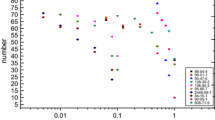Abstract
A structural similarity method was used to construct stable classificatory models for discriminating compounds with mechanisms of general toxicity to Daphnia magna compared with all other compounds with different actions, compounds with the polar narcosis mechanism compared with all others, compounds inhibiting cholinesterase compared with compounds with other mechanisms, and compounds with general toxic actions compared with substances with the polar narcosis mechanism. Simultaneous use of the classificatory and regression models allowed clear identification of substances acting via the general toxicity mechanism, with quantitative assessments of LC50 values and analysis of contributions of steric interactions and hydrogen bonds to toxicity. Our own experimental data on the toxicities (LC50) of 119 chemical compounds with different types of toxic actions to Daphnia magna are presented.
Similar content being viewed by others
References
P. H. Peters and R. de Bernardi (Eds.), DAPHNIA, Instituto Italiano di Idrobiologia, Verbania, Pallanza, Vol. 45 (1987).
V. B. Prozorovskii, Farmakol. Toksikol., 51, No. 4, 497–502 (1978).
O. A. Raevsky, V. Yu. Grigoriev, and S. V. Trepalin, HYBOT, Registration by the Russian State Patent Agency, No. 990090 (1999).
O. A. Raevsky, J. Phys. Organization. Cham., 10, No. 5, 405–413 (1997).
V. A. Gerasimenko, S. V. Trepalin, O. A. Raevsky, in: Molecular Modeling and Prediction of Bioactivity, K. Gundertofe and F. Jorgensen (Eds.), Kluwer Academic-Plenum Publishing (2000), pp. 423–424.
O. A. Raevsky, S. V. Trepalin, E. P. Trepalina, and O. E. Raevskaya, MOLDIVS: Registration by Russian State Patent Agency, No. 990093 (1999).
O. A. Raevsky, S. V. Trepalin, and E. P. Trepalina, Registration by Russian State Patent Agency, No. 990089 (1999).
L. Lipnick, in: Practical Application of Quantitative Structure-Activity Relationships (QSAR) in Environmental Chemistry and Toxicology, W. Karcher and J. Devillers (Eds.), Kluwer Academic Publishers, Dordrecht (1990), pp. 281–293.
O. A. Raevsky, SAR & QSAR in Environmental Res., 12, 367–381 (2001).
O. A. Raevsky, Minireview Med. Chem., 4, No. 10, 1041–1052 (2004).
Author information
Authors and Affiliations
Corresponding author
Additional information
__________
Translated from Khimiko-Farmatsevticheskii Zhurnal, Vol. 42, No. 6, pp. 22–27, June, 2008.
Rights and permissions
About this article
Cite this article
Raevskii, O.A., Razdol’skii, A.N., Tonkopii, V.D. et al. Classificatory and quantitative models of the relationship between the structures of chemical compounds and their toxicity for Daphnia magna . Pharm Chem J 42, 329–334 (2008). https://doi.org/10.1007/s11094-008-0119-5
Received:
Published:
Issue Date:
DOI: https://doi.org/10.1007/s11094-008-0119-5




